ArcBlock Review: Simple Dapp & Blockchain Development Platform
ArcBlock (ABT) is another project that is trying to simplify the process of Decentralised Application (dApp) and blockchain development.
The project launched with a sizable ICO back in 2018 and have been slowly building out their technology. Indeed, building a user friendly and scalable development platform is no small feat and there are many projects that are trying to achieve similar ends.
So, how is ArcBlock different from similarly ambitious projects?
In this review, I will give you everything that you need to know about ArcBlock. I will also analyse the long term use cases and adoption potential of the ABT tokens.
What is ArcBlock?
ArcBlock is a blockchain 3.0 platform that has taken dApp development and the creation of custom blockchains to a new level of simplicity for developers. It gives the foundational components necessary for building blockchain applications, such as flexible SDKs, code packages, developer tools, and services.
It also offers the ability to create enterprise level dApps and custom blockchains based on complex business rules. And it lets developers connect to any blockchain to get the results they need.
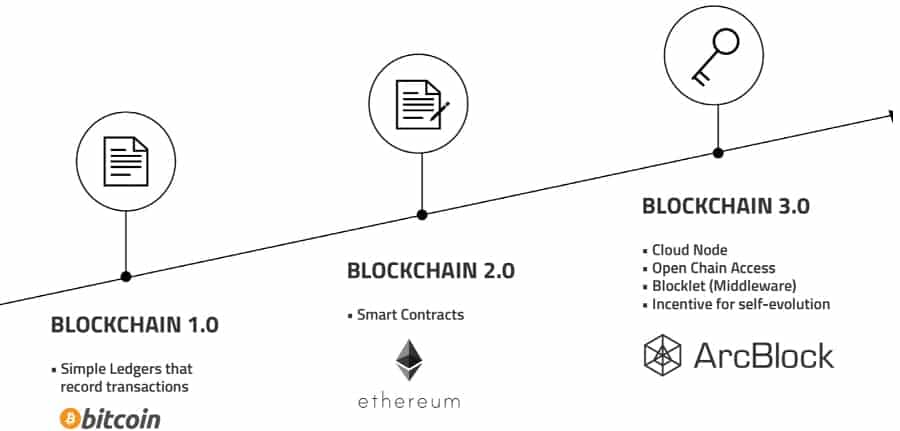
The objective of ArcBlock is to remove the barriers that have kept blockchain from being adopted by the general public. They are taking a unique approach to making development faster and easier, and to make finished products more usable by the general public and by businesses.
ArcBlock is working diligently to engineer the blockchain 3.0 platform that will give developers the ability to build, manage and deploy dApps with ease. The plan is to create a blockchain version of Ruby on Rails that gives developers all the basic components to make things work so that they can focus on writing code.
ArcBlock Solutions
The solution being proposed by ArcBlock will not only make dApp development easier and more accessible, but it also expects to solve the common blockchain problems such as the lack of features, poor performance, platform lock-in, cost, and a lack of user-friendliness.
ArcBlock is far more than a blockchain, instead, it can be defined as a platform service. This makes it far more powerful than the API set you can expect from most blockchain projects. ArcBlock should be thought of as a complete solution that combines blockchain technology with cloud computing.
ArcBlock has been designed to assist the developer with an incentive driven marketplace that includes reusable components and services. It will also change the role of miners in the community, making them much more than just a way for the network to secure computing resources. They will also contribute to the software components of the system, and as service providers, thus helping to build up the entire platform.
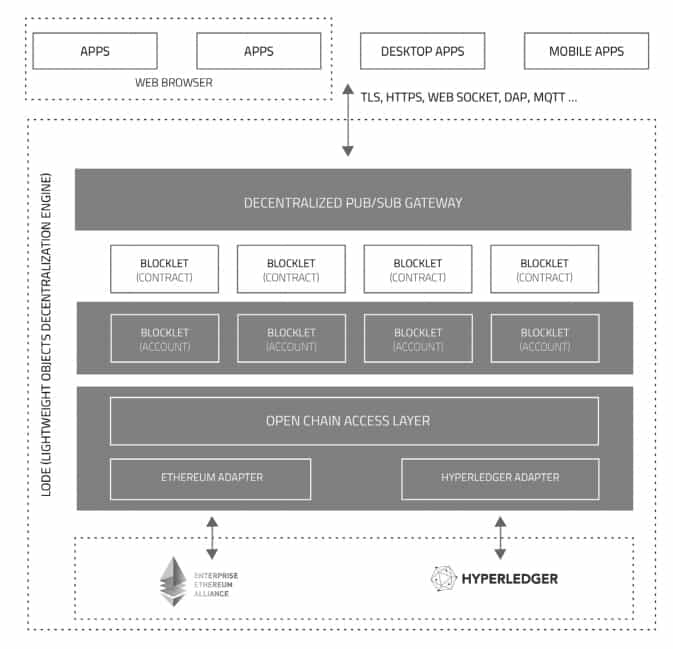
One of the most interesting and revolutionary features of ArcBlock is the Open Chain Access Protocol (OCAP). Enabling it allows for connectivity across a variety of blockchain protocols. This gives developers complete freedom in determining which platform will best serve their needs.
They can switch between available platforms without restriction, greatly expanding their flexibility. It is an abstraction layer that allows for development without complexity. Open-source code using industry leading tools means developers won’t need to worry about learning new languages or rebuilding business logic to accommodate new technology.
Blocklet
Another key component of the ArcBlock platform is the Blocklet. It takes advantage of server-less architecture to build services and applications. Blocklets are reusable and customizable for fast and powerful development within any platform the developer chooses.
It also allows for the use of any language, which gives developers more flexibility and the ability to make the best use of the native platform. Blocklets are used in the development of smart contracts, resources, asset handling, and off-chain business logic, among other things.
ArcBlock wasn’t developed simply for blockchain access. It can also connect with data sources, and can perform both on-chain and off-chain computations. This unique design gives ArcBlock a cost efficiency and high performance, while also making the platform more user friendly.
And with plans to make ArcBlock protocol agnostic, it will be technologically superior, allowing for the development of any and all blockchain 3.0 dApps.
ArcBlock Benefits
Aside from the common blockchain problems that will be resolved by ArcBlock, there are many other benefits that the platform can deliver. Below are some of the more prominent benefits of the platform:
Optimized for the Best User Experience
One of the features of ArcBlock is that it was designed for the best possible user experience. To achieve that the developers used a top down approach to promote a user-friendly experience based on blockchain technology.
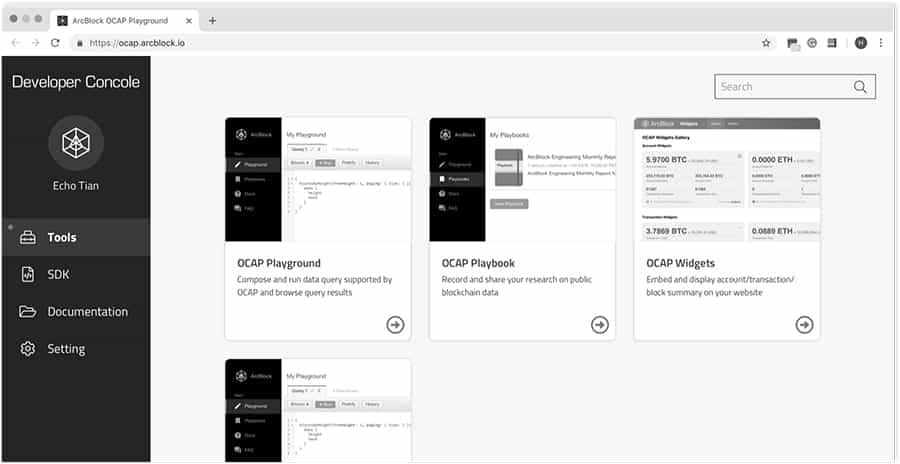
One of the keys to this user friendly development is that ArcBlock can be accessed via a web browser. There is no software to download, and users won’t even have to install a plug-in or extension. And mobile users will be able to download a simple to use app.
Designed for the Token Economy
ArcBlock is fully compatible with the emerging token economy, which will be increasingly important as the token economy becomes increasingly important. It is also self-evolving thanks to the decentralized nature of the platform and the inclusion of the community in the ongoing development of ArcBlock. The inclusion of token economics helps facilitate the development and evolution of the platform.
Open Standard Technology
The developers of ArcBlock have not tried to reinvent blockchain technology. Instead, they are using existing open-source technology wherever possible, making it even easier for developers to migrate their projects to ArcBlock.
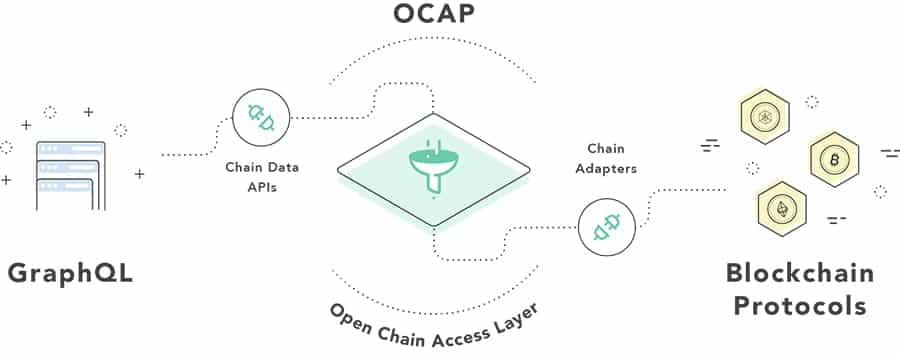
In addition to focusing on the needs of developers and open standards, ArcBlock has the ability to make contributions to all of the blockchain projects in the world through its Open Chain Access Protocol.
Designed for the Cloud
With software and business processes increasingly moving to the cloud it only makes sense for blockchain technology to do so as well, and ArcBlock was designed for the cloud. This is expected to be extremely beneficial as time goes on, especially as ArcBlock has been made cloud agnostic.
This will allow dApps to be deployed to any cloud infrastructure and run inside any web browser. No plug-ins, extensions or proprietary interface. Just open a web browser and get access to the apps and services you need. This is taking blockchain technology and decentralized applications to the next level.
The ArcBlock Team
The ArcBlock team comes with extensive experience in software engineering, entrepreneurship, and public relations.
The CEO, founder, and chief architect of the platform is Robert Mao, a longtime technology entrepreneur. Prior to founding ArcBlock, he was the co-founder and CEO of social media suite of tools known as Pixomobile. Pixomobile builds a suite of mobile apps and services to help users create, manage, consume and share their life moments through photos and videos directly from their mobile device.

The chief scientist for the ArcBlock project is Flavien Charlon, who was previously the founder and CEO of Coinprism, one of the earliest blockchain startups. He is also the co-founder and CTO at Trezeo, which is helping freelancers find financial stability.
Public relations for ArcBlock is handled by Jean Chen, who spent 14 years as a reporter in Shanghai. After that he transitioned into marketing, holding roles in marketing communications, branding and public relations.
Finally, software enginerring is overseen by Tyr Chen, who has spent 10+ years in software engineering with firms such as Juniper Networks and the startup Tubi TV.
ArcBlock Community
When it comes to increasing adoption for a cryptocurrency, having a strong and engaged community can help. Indeed, for a project like ArcBlock, more awareness means more developers and hence more people using their platform.
So, I decided to get a closer look at the Arcblock community following.
Firstly, ArcBlock has a pretty sizable Telegram following. They have over 15,000 followers in their official channel. I jumped into the channel to get a sense of the conversation.
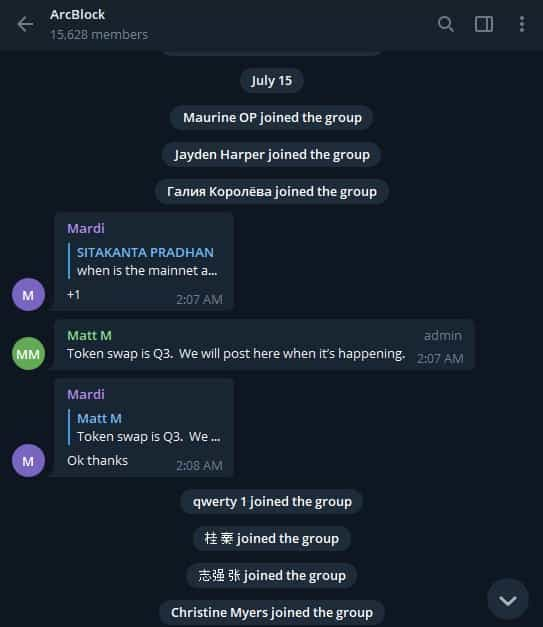
As you can see, there are thousands of followers but I was disappointed with the level of interaction between them. There was very little interesting discussions or a particularly engaged community. They do, however, have a WeChat group for their Chinese community.
ArcBlock also has an official Twitter account that has a just over 37k followers. This is relatively active with the team posting about once every two days. They also get a reasonable level of interaction with these tweets.
What I did find quite encouraging though is that they have a pretty technical "Engineering Blog". Here they keep their developer community abreast with the latest technology as well as some important tutorials.
The ABT Token
The ABT token is an ERC-20 token based on the Ethereum blockchain. There is a total supply of 186,000,000 ABT, and a current circulating supply of just over 98.5 million ABT.
ArcBlock held its ICO in February 2018 and even though the cryptomarkets were already cooling from their highs by that time the team was still able to raise $45 million, selling tokens at $0.50 each.
The token was released several weeks later and immediately more than doubled in price. It was soon trading above $1.30, but that didn’t last long and by April the token price was slipping below $0.60 as the cryptomarkets fell into a funk.
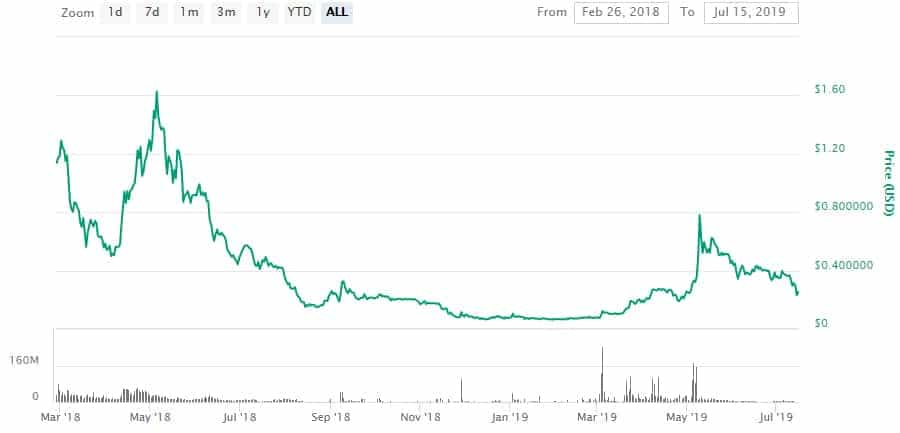
The May bounce in prices saw ABT hit an all-time high of $1.66 on May 5-6, 2018. After that price steadily retreated through 2018 and finally reached an all-time low of $0.054302 on January 29, 2019.
Price climbed steadily higher and reached levels above $0.70 in May 2019 as the entire cryptocurrency market has been recovering in 2019. Unfortunately, it wasn’t able to hold those May gains and as of July 15, 2019, it trades at $0.260798, or roughly half its ICO price.
Buying & Storing ABT
The ABT token trades on a good number of exchanges, with the top trade volume coming from the OKEx exchange. There’s an almost equal trade volume on the DragonEx exchange. Smaller trade volume exists on Huobi Global and Gate.io.
There are also healthy turnover levels on these exchanges. This means that there is healthy liquidity for ABT and you are unlikely to get a great deal of slippage from large block orders of the token.
Once you have purchased your ABT tokens then you are probably going to want to move them off the exchange and store them in an offline wallet. We are all aware of the risks of centralised exchange hacks.

Because ABT is an ERC-20 token it can be stored in any ERC-20 compatible wallet, such as MyEtherWallet. The ArcBlock team has also recently released its own ABT wallet, which includes a decentralized identity solution allowing users to take back control of their digital identity.
However, if you are looking for the safest option for offline storage then you can't beat the security of a hardware wallet. These keep your private keys in a "cold storage" environment with your keys far away from hackers.
Development & Roadmap
It can sometimes be hard to determine exactly how much work has been done on a project. However, one of the most accurate indications is to take a look at their public code repositories.
Hence, I decided to jump into the ArcBlock GitHub and take a look at the level of coding activity. One of the best metrics to zone in on is the code commits. Below we have the code commits for the top 3 most active repos.
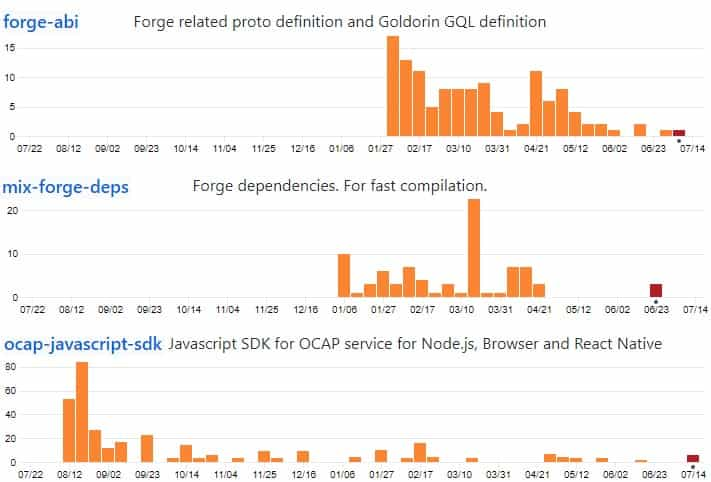
As you can see, the developers have been quite active and have regularly pushing code to these repos. It is also worth noting that there are a further 48 repositories in their GitHub (they have less commits though).
This level of development is about in line with other projects that we have covered at similar stages in their life.
Perhaps all of this coding activity can be related to their ambitious development plans and milestones. For example, their public roadmap is in fact quite extensive and is more comprehensive than we have seen on other projects.
It will be interesting to see if the developers are able to most effectively meet their upcoming milestones. If you wanted to follow the latest on the developments then you can head on over to their blog.
Conclusion
If they can deliver on their promise then it seems as if ArcBlock will be a major part of the upcoming Blockchain 3.0 technological revolution.
It will bring decentralized applications to the masses, and make the creation of these dApps simple for developers. It’s ability to connect between different protocols is a huge positive for the future of blockchain dApps.
There are several competitors working on interoperability, but ArcBlock is different, with its focus on cloud computing and building an ecosystem that allows developers to build, manage and run their blockchains and dApps easily.
The inclusion of OCAP and the Forge SDK makes ArcBlock a great way for developers to build blockchains and dApps. And the inclusion of cloud computing technology brings all this to end users right in their browsers, which promises ease of adoption and a rapidly growing community of users.
ArcBlock is working to make the decentralized web a reality, and is well on the way to succeeding. Investors may be somewhat troubled by the token performance however, as it seems to have difficulty remaining above its ICO price.
Disclaimer: These are the writer’s opinions and should not be considered investment advice. Readers should do their own research.
